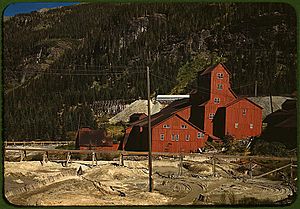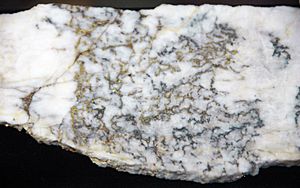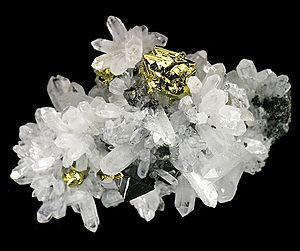Camp Bird Mine facts for kids

The Camp Bird Mine is a very famous and successful old gold mine. It is located in the beautiful San Juan Mountains of Colorado. You can find it between the towns of Ouray and Telluride, Colorado. This mine was part of a busy area known as the Sneffels-Red Mountain-Telluride mining district.
Contents
History of the Camp Bird Mine
Discovery and Early Days
The Camp Bird Mine was first discovered by a miner named Thomas F. Walsh in 1896. It quickly became known for its rich deposits of gold and silver. From 1896 to 1990, the mine produced a huge amount of precious metals. It yielded about 1.5 million troy ounces of gold. That's like 125,000 pounds of gold! It also produced 4 million troy ounces of silver.
In 1902, Thomas Walsh sold the mine for a large sum of money, US$5.2 million. His daughter, Evalyn Walsh McLean, later became famous for owning the Hope Diamond. She even wrote about the mine in her book, "Father Struck It Rich."
How the Mine Got Its Name
The Camp Bird Mine got its name from some friendly birds. These birds were probably Gray Jays. Miners called them "Camp Birds" because they would often try to eat the miners' lunches!
The Mine in Pop Culture
The Camp Bird Mine has even been featured in songs and books. A singer named C.W. McCall sang about it in a song. He mentioned "Way out in Colorado, in the Camp Bird Mine, down deep in the darkness, on level nine..." The song even added a ghost for fun! A writer named David Lavender also wrote about his experiences working at the mine in the 1930s.
Recent Activity and Environmental Efforts
Modern Operations
The Camp Bird Mine has been mostly quiet for some time. In late 2007, there was a plan to start mining again, but it didn't happen right away. In 2012, the mine received permits to fix up its old tunnels and workings.
Protecting the Environment
In August 2017, the Environmental Protection Agency (EPA) and the State of Colorado started working with the mine's new owners. The goal was to clean up the area around the mine. They wanted to stop contaminated soil from washing downstream. This cleanup work began in 2017 to help protect the environment.



